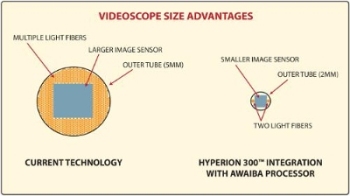Feb 3 2014
Surgeons can now explore parts of the human body with significantly more light and a higher resolution, higher quality image than was previously possible. Until the recent launch of the Hyperion 300™ Light Source with Integrated Awaiba Video Processor, the image quality from flexible endoscopes made it difficult to see into areas of the body that could only be reached with an in incision no smaller than 5mm or through a natural orifice.
This is about to change with a groundbreaking collaboration between two leaders in the medical device industry: Nathaniel Group of the United States, and Awaiba GmbH of Germany.
 The Hyperion 300(TM) and Awaiba Video Sensor product integration dramatically reduces the size of the flexible endoscope rendering it small enough for a 2mm incision, and inexpensive enough to make it disposable and suitable for single use. (PRNewsFoto/Nathaniel Group, Inc.)
The Hyperion 300(TM) and Awaiba Video Sensor product integration dramatically reduces the size of the flexible endoscope rendering it small enough for a 2mm incision, and inexpensive enough to make it disposable and suitable for single use. (PRNewsFoto/Nathaniel Group, Inc.)
With the smaller and lower cost Awaiba processor, and the advanced illumination technology from Nathaniel Group, surgeons can navigate further within the body faster and more easily. Better accuracy improves their ability to address cancers of the lung and pancreas, organ removal, liver or kidney damage, and arthritis, among other things.
The combination of Awaiba's state-of-the-art sensor, an unusually small and low cost product, and the superior light output from Nathaniel Group's Hyperion 300 makes Nathaniel's video scopes suitable for single-use applications eliminating the need to sterilize to reuse them.
As shown in the diagram below, the Hyperion's small optical fibers are able to pack closely into the sensor body, maintaining all the advantages of the sensor's small size.
The integration of the Hyperion 300 with the Awaiba Video Processor benefits both doctors and patients. The smaller size and superior illumination allows surgeons to see further into the body, enabling them to study more closely various diseases. With fewer and less expensive parts, the price tag for medical devices for exploratory surgery is much lower. Lastly, a smaller incision during minimally invasive surgery leads to less damage to the human body and faster patient recovery times.
For more information or to download the White Paper go to www.nathaniel.com.